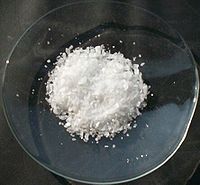
Photo from wikipedia
The rapid accumulation of dead bacteria or protein on a bactericidal surface can reduce the effectiveness of the modified surface and alter its biocidal activity by shielding the surface biocide… Click to show full abstract
The rapid accumulation of dead bacteria or protein on a bactericidal surface can reduce the effectiveness of the modified surface and alter its biocidal activity by shielding the surface biocide functional groups, promoting microbial attachment and subsequent biofilm formation. Thus, the alteration of biocidal activity due to biofilm formation can cause serious trouble including severe infection or implant or medical device failure leading to death. Therefore, developing a smart self-cleaning surface is of great interest. Ideally, such a surface can not only kill the attached microbials but also release the dead cells and foulants from the surface under a particular incitement on demand. In this project, a sugar-responsive self-cleaning coating has been developed by forming covalent boronic ester bonds between catechol groups from polydopamine and a benzoxaborole pendant from zwitterionic and cationic polymers. To incorporate antifouling properties and enhance the biocompatibility of the coating, bioinspired zwitterionic compound 2-methacryloyloxyethyl phosphorylcholine (MPC) was chosen and benzoxaborole pendant containing zwitterionic polymer poly(MPC-st-MAABO) (MAABO: 5-methacrylamido-1,2-benzoxaborole) was synthesized. Additionally to impart antibacterial properties to the surface, a quaternary ammonium containing cationic polymer poly(2-(methacryloyloxy)ethyl trimethylammonium (META)-st-MAABO)) was synthesized. These synthesized polymers were covalently grafted to a polydopamine (PDA) coated surface by forming a strong cyclic boronic ester complex with a catechol group of the PDA layer endowing the surface with bacteria contact-killing properties and capturing specific protein. After the addition of cis-diol containing competitive molecules, i.e., saccharides/sugars, this boronic ester complex with a catechol group of PDA was replaced and the attached polymer layer was cleaved from the surface, resulting in the release of both absorbed protein and live/killed bacteria electrostatically attached to the polymer layer. This dynamic self-cleaning surface can be a promising material for biomedical applications avoiding the gathering of dead cells and debris that are typically encountered on a traditional biocidal surface.
Journal Title: ACS applied materials & interfaces
Year Published: 2022
Link to full text (if available)
Share on Social Media: Sign Up to like & get
recommendations!